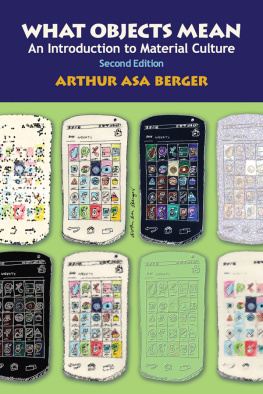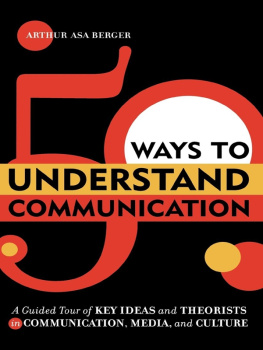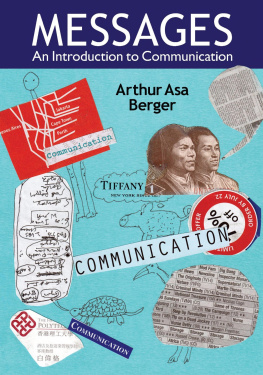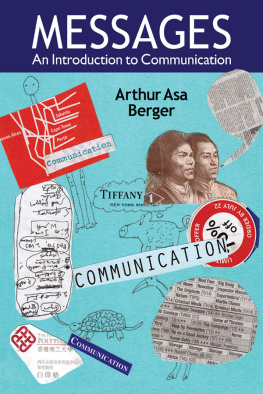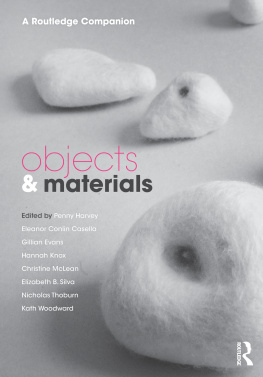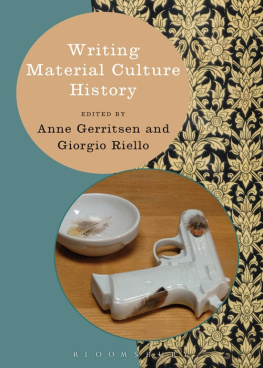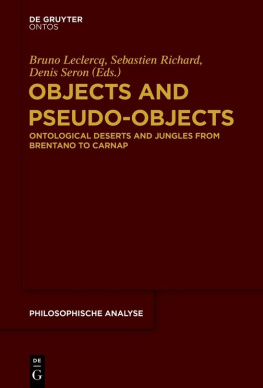First published 2014 by Left Coast Press, Inc.
Published 2016 by Routledge
2 Park Square, Milton Park, Abingdon, Oxon OX14 4RN
711 Third Avenue, New York, NY 10017, USA
Routledge is an imprint of the Taylor & Francis Group, an informa business
Copyright 2014 Taylor & Francis
All rights reserved. No part of this book may be reprinted or reproduced or utilised in any form or by any electronic, mechanical, or other means, now known or hereafter invented, including photocopying and recording, or in any information storage or retrieval system, without permission in writing from the publishers.
Notice:
Product or corporate names may be trademarks or registered trademarks, and are used only for identification and explanation without intent to infringe.
Library of Congress Cataloging-in-Publication Data:
Berger, Arthur Asa, 1933
What objects mean : an introduction to material culture / Arthur Asa Berger. Second edition.
pages cm
Summary: Arthur Asa Berger, author of an array of texts in communication, popular culture,and social theory, is back with the second edition of his popular, user-friendly guide for studentswho want to understand the social meanings of objects. In this broadly interdisciplinary text,Berger takes the reader through half a dozen theoretical models that are commonly used toanalyze objects. He then describes and analyzes eleven objects, many of them new to thiseditionincluding smartphones, Facebook, hair dye, and the American flagshowing how theydemonstrate concepts like globalization, identity, and nationalism. The book includes a series ofexercises that allow students to analyse objects in their own environment. Brief and inexpensive,this introductory guide will be used in courses ranging from anthropology to art history, popculture to psychologyProvided by publisher.
Includes bibliographical references and index.
ISBN 978-1-61132-904-9 (paperback) ISBN 978-1-61132-906-3 (consumer eBook)
1. Material culture. 2. Material culturePhilosophy. 3. CultureSemiotic models. I. Title.
GN406.B473 2014
306.46dc23
2014007949
ISBN 978-1-61132-904-9 paperback
This book briefly explains six methodologies that you, the student, can use in various permutations and combinations to analyze material culture. These methodologies are:
Freudian Psychoanalytic Theory
Semiotic Theory
Sociological Theory
Marxist Theory
Cultural Theory
Archaeological Theory
I offer these theories because I believe the best way to make sense of objects and artifacts is to use relevant ideas and concepts from all of the theories in making your analysesthat is, for you to use a multidisciplinary approach to material culture.
After explaining these theories in I offer interpretations of a number of objects, based on the theories Ive explicated and using material from authors in various disciplines. I also apply a number of the concepts and theories found in the theory part of the book to these artifacts. I conclude each discussion of an artifact by offering some questions that will help you know what to look for as you analyze that and other artifacts. This book will help you learn how to make your own analyses and interpretations of objects and artifacts using combinations of semiotic, sociological, psychoanalytic, anthropological, economic (Marxist), and archaeological theories.
In I offer some games that ask you to apply what youve learned in the first two parts of the book. These learning games can be played in class in groups of three students (which Ive found to be the best arrangement) or can be assigned as homework. When I taught, I often used learning games in my courses and found that my students enjoyed them. At the same time, they learned a good deal from playing these games, because they were required to apply ideas and concepts they had learned.
The games can also be assigned as homework projects. That is, each student would be asked to play the game and come up with answers or whatever else was required. When I played the games in class, I selected one person as the scribe, whose duty was not only to participate in playing the game but also to record the answers the group decided upon. After wed devoted 20 or 30 minutes to the game, the scribes would report their teams answers to the class, and the whole class would then discuss the validity of the answers given by the various teams.
I believe that the best way for you to learn about material culture is for me to provide you with methodologies or techniques that you can use to make your own analyses of artifacts and objects of interest. Quite likely, youve already spent a good deal of time thinking about various objects and other kinds of material culture (things you wanted to buy and things given to you), but youve probably never been exposed to methods that will help you understand how to make sense of the objects and artifacts that play such a big part in your and everyone elses lives.
I have selected those aspects of the theories I deal with that are most useful in analyzing material culture and have not attempted a comprehensive look at any of the disciplines. I think using a number of disciplines will provide you, my readers, with a broader perspective on material culture than single disciplinary approaches. As you will see, material culture is a subject of interest to people in many different disciplines in the social sciences and humanities. In this second edition of What Objects Mean: An Introduction to Material Culture you will find the following enhancements:
Martin Grotjahn on symbols
A new definition of the concept of culture
Clifford Geertz on symbols
Roland Barthes on the semiotics of objects
Jean Baudrillard on the system of objects
John Berger on advertising and objects
Erik Eriksons psychoanalytic theories applied to smartphones
Marcel Danesi on myth and culture
My explanation of the myth model applied to objects
A new learning game based on the myth model
New chapters on Blonde Hair Dye, Bagels, Manga, and the American Flag
An updated chapter on technology and smartphones, sociability, and Facebook
I hope you will find this new edition both interesting and useful, and that it will help you see the objects around you and the objects you own in new ways.
Acknowledgments
I want to thank Mitch Allen, whom Ive worked with since 1982, for suggesting I write this book and write a second edition of it five years later. We had lunch at a Dim Sum restaurant in San Francisco a number of years ago, and he thought it would be interesting for me to do more work on material culture. I had already written a book, Blooms Morning, that analyzed various artifacts and rituals in a typical Americans morning, so I was interested in trying my hand at the subject again. Originally, I was to write a book on methods and another one analyzing a large number of objects, but we finally decided it made more sense to put the two projects together into one book.

